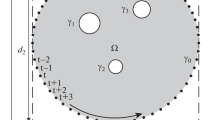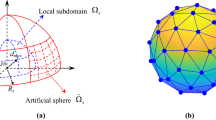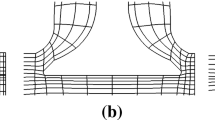Abstract
We propose a new and simple technique called the Symmetric Smoothed Particle Hydrodynamics (SSPH) method to construct basis functions for meshless methods that use only locations of particles. These basis functions are found to be similar to those in the Finite Element Method (FEM) except that the basis for the derivatives of a function need not be obtained by differentiating those for the function. Of course, the basis for the derivatives of a function can be obtained by differentiating the basis for the function as in the FEM and meshless methods. These basis functions are used to numerically solve two plane stress/strain elasto-static problems by using either the collocation method or a weak formulation of the problem defined over a subregion of the region occupied by the body; the latter is usually called the Meshless Local Petrov–Galerkin (MLPG) method. For the two boundary-value problems studied, it is found that the weak formulation in which the basis for the first order derivatives of the trial solution are derived directly in the SSPH method (i.e., not obtained by differentiating the basis function for the trial solution) gives the least value of the L2-error norm in the displacements while the collocation method employing the strong formulation of the boundary-value problem has the largest value of the L2-error norm. The numerical solution using the weak formulation requires more CPU time than the solution with the strong formulation of the problem. We have also computed the L2-error norm of displacements by varying the number of particles, the number of Gauss points used to numerically evaluate domain integrals appearing in the weak formulation of the problem, the radius of the compact support of the kernel function used to generate the SSPH basis, the order of complete monomials employed for constructing the SSPH basis, and boundary conditions used at a point on a corner of the rectangular problem domain. It is recommended that for solving two-dimensional elasto-static problems, the MLPG formulation in which derivatives of the trial solution are found without differentiating the SSPH basis function be adopted.
Similar content being viewed by others
References
Lucy LB (1977). A numerical approach to the testing of the fission hypothesis. Astron J 82: 1013–1024
Chen JK, Beraun JE and Jin CJ (1999). An improvement for tensile instability in smoothed particle hydrodynamics. Comput Mech 23: 279–287
Chen JK, Beraun JE and Jin CJ (1999). Completeness of corrective smoothed particle method for linear elastodynamics. Comput Mech 24: 273–285
Liu WK, Jun S and Zhang YF (1995). Reproducing kernel particle methods. Int J Num Meth Fluids 20: 1081–1106
Liu WK, Jun S, Li S, Adee J and Belytschko T (1995). Reproducing kernel particle methods for structural dynamics. Int J Num Meth Eng 38: 1655–1679
Chen JS, Pan C, Wu CT and Liu WK (1996). Reproducing kernel particle methods for large deformation analysis of non-linear structures. Comput Method Appl Mech Eng 139: 195–227
Zhang GM and Batra RC (2004). Modified smoothed particle hydrodynamics method and its application to transient problems. Comput Mech 34: 137–146
Batra RC and Zhang GM (2004). Analysis of adiabatic shear bands in elasto-thermo- viscoplastic materials by modified smoothed-particle hydrodynamics (MSPH) method. J Comput Phys 201: 172–190
Zhang GM and Batra RC (2007). Wave propagation in functionally graded materials by modified smoothed particle hydrodynamics (MSPH) method. J Comput Phys 222: 374–390
Batra RC and Zhang GM (2007). Search algorithm and simulation of elastodynamic crack propagation by modified smoothed particle hydrodynamics (MSPH) method. Comput Mech 40: 531–546
Zhang GM, Batra RC (2006) Symmetric smoothed particle hydrodynamics (SSPH) method and its application to 2-D elastic problems (submitted)
Belytschko T, Lu YY, Gu L and Tabbara M (1995). Element-free Galerkin methods for static and dynamic fracture. Int J Solids Struct 32: 2547–2570
Belytschko T, Lu YY and Gu L (1994). Element-free Galerkin methods. Int J Num Meth Eng 37: 229–256
Atluri SN, Kim H-G and Cho JY (1999). A critical assessment of the truly Meshless Local Petrov–Galerkin (MLPG), and Local Boundary Integral Equation (LBIE) methods. Comput Mech 24: 348–372
Kim DW and Liu WK (2006). Maximum principle and convergence analysis for the meshfree point collocation method. SIAM J Numer Anal 44: 515–539
Kim DW, Yoon YC, Liu WK and Belytschko T (2007). Extrinsic meshfree approximation using asymptotic expansion for interfacial discontinuity of derivative. J Comput Phys 221: 370–394
Li SF and Liu WK (1999). Reproducing kernel hierarchical partition of unity, part I—formulation and theory. Int J Num Meth Eng 45: 251–288
Li SF and Liu WK (1999). Reproducing kernel hierarchical partition of unity, part II—applications. Int J Num Meth Eng 45: 289–317
Belytschko T, Krongauz Y, Dolbow J and Gerlach C (1998). On the completeness of meshfree particle methods. Int J Num Meth Eng 43: 785–819
Gunther F, Liu WK, Diachin D and Christon MA (2000). Multi-scale meshfree parallel computations for viscous, compressible flows. Comput Methods Appl Mech Eng 190: 279–303
Ferreira AJM (2003). Thick composite beam analysis using a global meshless approximation based on radial basis functions. Mech Adv Mater Struct 10: 271–284
Qian LF, Batra RC and Chen LM (2003). Elastostatic deformations of a thick plate by using a higher-order shear and normal deformable plate theory and two meshless local Petrov–Galerkin (MLPG) methods. CMES Comput Model Eng Sci 4: 161–175
Batra RC, Porfiri M and Spinello D (2004). Treatment of material discontinuity in two meshless local Petrov–Galerkin (MLPG) formulations of axisymmetric transient heat conduction. Int J Num Meth Eng 61: 2461–2479
Xiao JR and McCarthy MA (2003). A local Heaviside weighted meshless method for two-dimensional solids using radial basis functions. Comput Mech 31: 301–315
Lancaster P (1969). Theory of matrices. Academic, New York
David PJ (1963). Interpolation and approximation. Dover Publications, New York
Lancaster P and Salkauskas K (1981). Surface generated by moving least squares method. Math Comput 37: 141–158
Timoshenko SP and Goodier JN (1970). Theory of elasticity, 3rd edn. McGraw-Hill, New York
Batra RC and Liang XO (1997). Finite dynamic deformations of smart structures. Comput Mech 20: 427–438
Qian LF, Batra RC and Chen LM (2004). Static and dynamic deformations of thick functionally graded elastic plate by using higher-order shear and normal deformable plate theory and meshless local Petrov–Galerkin method. Composites Part B 35: 685–697
Qian LF and Batra RC (2004). Transient thermoelastic deformations of a thick functionally graded plate. J Therm Stresses 27: 705–740
Qian LF, Batra RC and Chen LM (2003). Free and forced vibrations of thick rectangular plates by using higher-order shear and normal deformable plate theory and meshless Petrov-Galerkin (MLPG) method. CMES: Comput Model Eng Sci 4: 519–534
Qian LF, Batra RC and Chen LM (2004). Analysis of cylindrical bending thermoelastic deformations of functionally graded plates by a meshless local Petrov-Galerkin method. Comput Mech 33: 263–273
Qian LF and Batra RC (2005). Design of bidirectional functionally graded plate for optimal natural frequencies. J Sound Vib 280: 415–424
Qian LF and Batra RC (2005). Three-dimensional transient heat conduction in a functionally graded thick plate with a higher-order plate theory and a meshless local Petrov-Galerkin method. Comput Mech 35: 214–226
Author information
Authors and Affiliations
Corresponding author
Rights and permissions
About this article
Cite this article
Batra, R.C., Zhang, G.M. SSPH basis functions for meshless methods, and comparison of solutions with strong and weak formulations. Comput Mech 41, 527–545 (2008). https://doi.org/10.1007/s00466-007-0209-3
Received:
Accepted:
Published:
Issue Date:
DOI: https://doi.org/10.1007/s00466-007-0209-3




